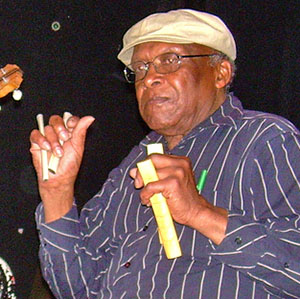
Ervin, of Everett, sometimes played wooden African drums to attract customers to his Knots and Things booth. But his treasured instruments were the bones—flat sticks made from golden wood that sound like castanets when struck together.”Every country in the world has a clapping instrument, and bones are probably the oldest,” Ervin said.
When Ervin was a young boy in the East Texas town of Tyler, local blues musicians noticed he kept a good rhythm with just a pair of sticks. So they taught him how to play with ordinary objects such as spoons and animal bones. Ervin found his first pair of cow bones in a neighbor’s pasture. Later he made pairs by boiling the meat off rib bones, then cleaning out the marrow with a clothes hanger. The oil from his hand would polish the bones to a fine sheen. Most pairs of musical bones —originally actual bones but now often made of wood —are 5 to 7 inches long and vary in width. Thin bones have a snappy sound, Ervin said, and thicker pairs sound more “mellow.”
Ervin explained how playing the bones works: The player holds one bone tightly between the index and middle finger. That piece is held in place and struck rapidly with the second bone, which is held loosely be-tween the little and ring fingers.”It’s all in the wrist,” Ervin said as he raked his hand back and forth. “Your hand is the resonator. By moving the bones up and down, you get a different sound.”
